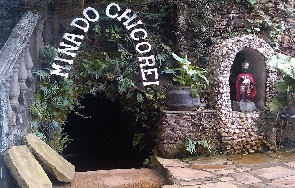Enslaved African Chico Rei hid gold in his hair to raise funds to buy his freedom

Chico Rei is believed to have hailed from the West Central African Kingdom of Kongo. He was born in the early 1800s into the royal family. His fortunes took a different twist when some members of his family and himself were captured by slave raiders and shipped to work on the plantations in Europe.
Chico and his family were put in the hilly region of Vila Rica where they worked in the gold mines of Minas Gerais. While working the mines, Chico was determined to attain his freedom from the harsh conditions of the mine pits.
He began hiding the gold he picked from working in the mines. When he had enough, he sold it to buy his freedom. He proceeded to rescue his family after he made enough profits from a goldfield he bought in Vila Rica, shortly after he became a free man.
Oral tradition also states that the gold he used to purchase his freedom came from his former slave owner as a gift for his sterling work output. Historical records posit that when Chico and his family established themselves after their freedom, they initiated steps to have the Church of Saint Iphigenia built which is currently being used by the Brotherhood of Our Lady of Rosary.
Brazilian historian Diogo Luiz de Almeida Pereira de Vasconcelos wrote about the exploits of Chico in his book ‘História antiga de Minas’ published in 1904. Chico has become a folklore legend in Brazilian popular culture with schools and theatres staging drama and plays about his feats. In 1964, Rio de Janeiro’s Salgueiro samba school held a play depicting the heroic deeds of Chico Rei.
The character Chico symbolizes the horrors of Africans captured and placed in the mines and plantations of European states, their trials while under captivity and their eventual freedom. His story has been used by playwrights and local Afro-Brazilian groups to promote the story of resilience and victory by enslaved people.
A discovery of a mine blocked with stones by a local resident in 1946 has been named Chico Rei’s mine. The mother of the teenager who found the gold mine was resolute it was synonymous with what was described in Histórias da terra mineira by Maria Bárbara de Lima. It has been decorated with lights to increase visibility in the one-mile-deep mine shaft.
The authorities have used the place to promote tourism by setting up a small restaurant and opening it to the public. Over half a decade now, there has been a conscious effort to promote the values of Chico Rei in scholarly articles and literature in Portuguese, English, and Spanish.
His story is important because the Afro-Brazilian population, though in the minority, has become a significant pillar in the history and economic growth of Brazilian society.
CLICK HERE TO DOWNLOAD PRESS RADIO MOBILE APP
He is believed to have lived the different sordid experiences many enslaved people endured after being shipped from Africa to work in the gold mines of southeastern Brazil and earn his freedom through his ingenuity.
Source: face2faceafrica.com







